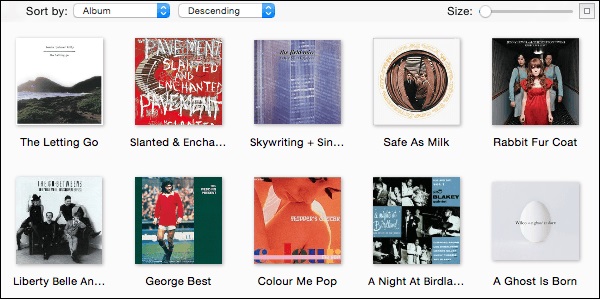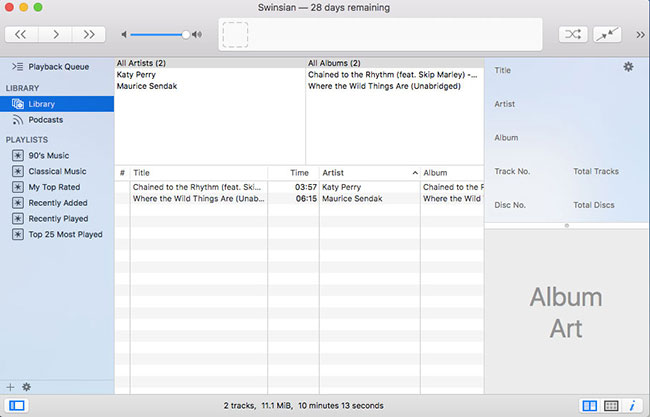Swinsian is an advanced music player and manager for Mac OS X supporting FLAC, MP3, Vorbis, WMA and more. Discover Swinsian alternatives, reviews, features and functionalities. Swinsian is an excellent Mac OS X music management alternative to iTunes. It is especially well-suited for large music collections and does not suffer from the same feature bloat as iTunes. The swinsian2itlxml script is an attempt to bridge the gap between Swinsian and DJ software such as Serato by generating an iTunes XML file. Swinsian is a sophisticated music player that offers wide format support, folder watching, and advanced tag editing. Swinsian also offers customization tools that enrich the overall experience and make it easier to navigate through music files. Swinsian is a sophisticated music player for macOS with wide format support, folder watching, advanced tag editing and designed to be responsive even with the largest libraries. Customise The art grid, column browser and track inspector provide multiple ways to view and navigate your music.
If you’re looking mostly for something that will replace the media player aspects of iTunes and do little else, then Swinsian might be the application for you. It also looks a lot like iTunes, so it’s easy to adapt. Some of its features include: Automatic AirPlay port detection. Easy meta data editing.
My nit-picking complaints about iTunes 12.7 (see here and here) have led me to start experimenting with Swinsian (on my Mac) and MediaMonkey (on my PC). I’ll get to MediaMonkey in a later post, but I thought I’d write up some notes on Swinsian.

As you can see in the screenshots below, Swinsian does fix my current gripe with iTunes: the browser at the top of the window shows a perfectly reasonable number of rows, by default (vs. iTunes: 3 rows). That browser is also very customizable in Swinsian: you can have between 1 and 3 columns, and you have several options as to what you display in them. The screenshot below shows two columns, for artist and album. You can easily change that to show genre, artist, and album, similar to iTunes.
Another thing I appreciate is that Swinsian has a “large text” option. The default text size was a little too small for my tired old eyes, so I turned that on right away.

Pulling in my music from iTunes to Swinsian was easy. It imported everything, including play counts and playlists. There are a few ways you can set things up, but (for now) I’m leaving my music in the iTunes library and folder structure, and letting Swinsian re-scan the library on startup. This allows me to add music in iTunes, which should then show up in Swinsian the next time I start it up. That arrangement probably makes the most sense for someone like me, since I still want to be able to sync music to my phone from iTunes. (Swinsian can sync to older iPods, but not to iOS devices.)
I only have a few issues with Swinsian, and they’re mostly related to the necessity to keep iTunes going. (If I could abandon iTunes and let Swinsian manage all my music, things would be smoother.) Probably the biggest one right now is that Swinsian doesn’t really distinguish audiobooks as a separate category, the way iTunes does. So all of my audiobooks are intermixed with my music. I’m not sure how to get around that one, or if it’s really that big a deal. If I was fully committing to Swinsian, I’d just leave the audiobooks in iTunes and move the music to Swinsian, and everything would be fine.
I’m also not sure that I like the way it handles “album artists” vs “artists”. It’s got some flexibility on that, but it’s not completely consistent. You can see the issue on the McCartney box set shown in the screenshots below. In iTunes, the track list correctly shows the track artist (sometimes McCartney, sometimes Wings), while in Swinsian, it’s always showing the album artist in the track list (though it does show the correct artist in the detail pane on the right). That’s not really a big deal, but it would be nice if they fixed that. Beam for mac.
Going back to my gripe about the top browser view in iTunes, I found a discussion thread related to it on the Apple site today. It kind of sounds like they might recognize it as a bug and fix it in the next release. Here’s hoping!
Here are some of the best iTunes alternative software packages:
1 iMyFone TunesMate
iMyFone TunesMate is a simple alternative to iTunes that nonetheless has many features. With this program, you can back up your files, as well as transfer a variety of file formats between your devices. You could say that it sets your iOS device free.
Some key features that really set TunesMate apart include:
- Support for all iOS devices.
- The ability to transfer data between your iPad / iPhone/iPod and iTunes.
- The ability to transfer files of many kinds from your device to your PC and vice versa.
- The ability to transfer files of many kinds from your device to your PC and vice versa.
- Many kinds of files are supported, such as photos, videos, music, playlists, voice memo, contacts, etc.
This application is really easy to use, and in fact you can transfer your iOS files in just a few simple steps: Photoshop free for mac 2015.
Step 1: First have your computer installed TunesMate. Launch TunesMate and then plug in your device a via USB cable.
Step 2: On the left, choose your device from a list. The program will automatically detect it.
Step 3: Choose what sort of files you wish to transfer, and then select the individual files as they come up on the right. From there, you can export them.
2 WonderShare TunesGo
WonderShare TunesGo is a valiant attempt to all-out iTunes alternative with something better. It includes a music player and a device management function.
Some of its best feature include:
- The ability to sync your iTunes data with other devices, including even Android phones.
- The ability to import music from your iOS devices and transfer them to your computer.
- And of course, the ability to transfer from your computer to your iOS device.
It’s available for both Mac and PC, though the Mac version is paid only.
3 MediaMonkey
Another alternative to iTunes as a media player and manager, MediaMonkey does a fairly decent job of it. If you want something that also comes with a built-in player and helps you organize your files, MediaMonkey is worth a try. Some important features include:

- Finding and automatically populating your music file lists with album art.
- Finding and automatically populating your music file lists with album art.
- Can rip music from physical media.
- Can sync to many different kinds of devices.

Swinsian Mac
This software appears to only be available for Windows. Its ability is for media but not for other files. Its interface is not user-friendly enough and in an old-fashion style.
4 Syncios
This is a straight-up device manager that is simple. It does only a few things, but it does them very well, and it allows you transfer data to or from your iOS device, as well as backup that data with ease. Here are some of its more notable features:
Swinsian Download
- Easy media transfer with just a few clicks.
- Transfers most types of files.
- Easy back-up function.
- Can be downloaded for free.
SynciOS is unfortunately only for Windows.
5 Swinsian
Swinsian Dark Mode
If you’re looking mostly for something that will replace the media player aspects of iTunes and do little else, then Swinsian might be the application for you. It also looks a lot like iTunes, so it’s easy to adapt. Some of its features include:
- Automatic AirPlay port detection.
- Easy meta data editing.
- Simple, user-friendly interface that will be familiar to iTunes users.
Some of the downsides for this one, though, are that it’s only available for Mac and that it doesn’t really function very well as a device manager. Cd rom drive for mac.
Comparisons
Here is an overview of all of these programs so you can get a better feel for what they have to offer.
MediaMonkey | Swinsian |
|---|---|
Has media player built in | |
Transfer files between PC and iOS device | |
Support different types of files | |
Has increased functionality as an alternative to iTunes |
